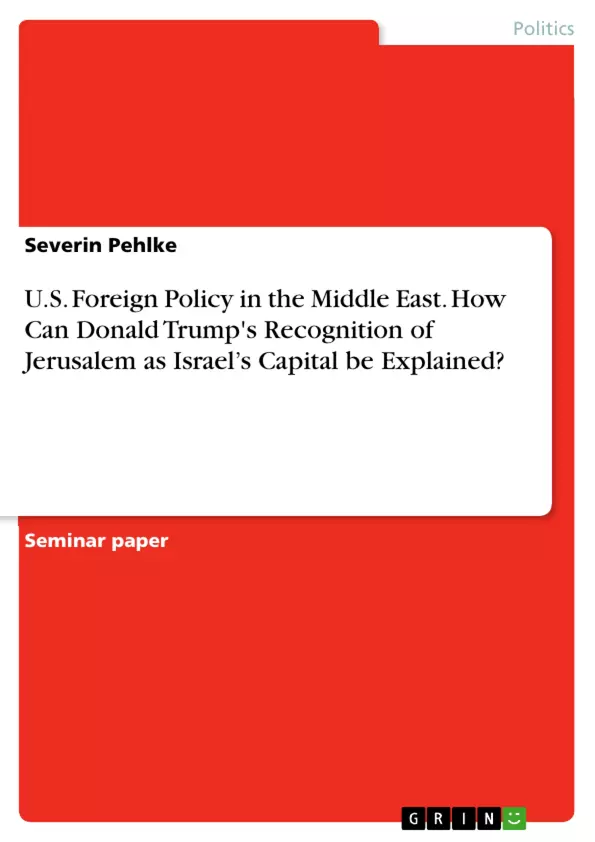The status of Jerusalem has always been a very sensitive, symbolic and central issue regarding the Arab-Israeli conflict.
This leads to the central question of this essay: How can the recognition of Jerusalem as the capital of Israel by the Trump administration be explained through either a structural realist or constructivist approach?
For Palestinians and Israelis, for Muslims, Christians and Jews around the world, Jerusalem is an anchor of modern identity. The Israelis claim it as the capital of their nation, the Palestinians want it to be the center of their hoped-for future state. The issue has gained a critical urgency and relevance recently, because on December 6, 2017 US-President Donald J. Trump announced the recognition of Jerusalem as the capital of Israel. By reversing seven decades of US neutrality and appeasement policy in this matter, his decision caused a lot of frustration among the Arabic community and states around the world. The UN General Assembly called the status of Jerusalem as Israel’s capital "null and void" - a pretty extraordinary situation of disagreement between the UN and the United States (Res. ES-10/L.22 2017).
This essay will establish a theoretical framework, by comparing the two schools of thought within the rational-constructivist debate. Subsequently, both theories will be applied on the present case of US foreign policy, after having ensured contextual understanding by going through essential historical aspects of US-Israeli relations and the effects of Trump’s decision.
Inhaltsverzeichnis (Table of Contents)
- Introduction
- Theoretical Framework
- Structural Realism
- Constructivism
- Contextual Background
- US-Israeli relationship
- Jerusalem Embassy Act 1995
- US recognition of Jerusalem as the capital of Israel
- Application of the Theoretical Framework on the Case
- Structural Realist Approach
- Constructivist Approach
- Conclusion
Zielsetzung und Themenschwerpunkte (Objectives and Key Themes)
This essay analyzes the recognition of Jerusalem as the capital of Israel by the Trump administration using both a structural realist and a constructivist approach. It aims to demonstrate the limitations of structural realism in explaining this decision, particularly regarding the role of US-Israeli relations and the lack of immediate threats to the United States. Conversely, the essay explores the ability of constructivism, particularly through the lens of shared values and common identity, to provide a more robust explanation.
- US foreign policy towards Israel
- The role of identity in international relations
- The debate between structural realism and constructivism
- The impact of shared values and common identity on alliances
- The status of Jerusalem in the Arab-Israeli conflict
Zusammenfassung der Kapitel (Chapter Summaries)
- Introduction: This chapter establishes the context for the essay by highlighting the significance of Jerusalem in the Arab-Israeli conflict and the recent decision by US President Trump to recognize Jerusalem as Israel's capital. It outlines the essay's objectives and the two theoretical frameworks that will be used to analyze this decision.
- Theoretical Framework: This chapter introduces the two theoretical frameworks that will be applied to the case study: structural realism and constructivism. It provides a brief overview of each theory and its main points, focusing on their approaches to the formation of alliances and the role of state identity.
- Structural Realism: This chapter delves deeper into the theory of structural realism, outlining its key assumptions, including the concept of an anarchic international system, the security dilemma, and the balance-of-power theory. It discusses the role of alliances in structural realism, emphasizing the importance of security concerns and the secondary role of ideology in shaping partnerships.
- Constructivism: This chapter presents the constructivist perspective as a counterpoint to structural realism. It highlights the importance of identity in shaping state behavior and the concept of shared values and common identity in the formation of alliances. It emphasizes the role of discourse and socialization in shaping the international system.
Schlüsselwörter (Keywords)
Key terms and concepts explored in this essay include structural realism, constructivism, state identity, shared values, common identity, US foreign policy, Israel, Palestine, Jerusalem, Arab-Israeli conflict, and the security dilemma.
- Quote paper
- Severin Pehlke (Author), 2018, U.S. Foreign Policy in the Middle East. How Can Donald Trump's Recognition of Jerusalem as Israel’s Capital be Explained?, Munich, GRIN Verlag, https://www.grin.com/document/538877



